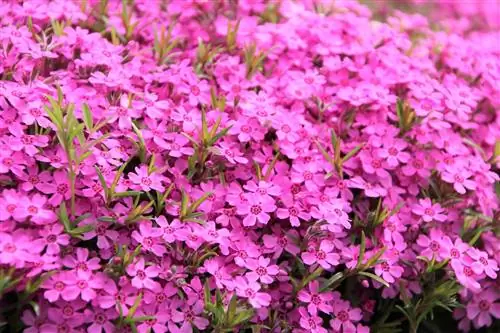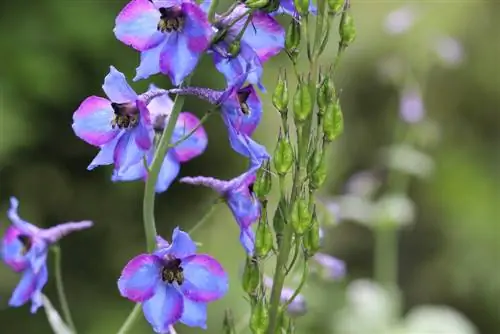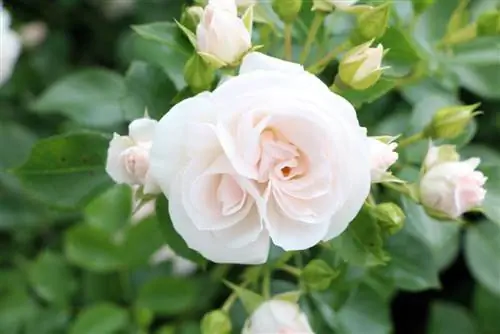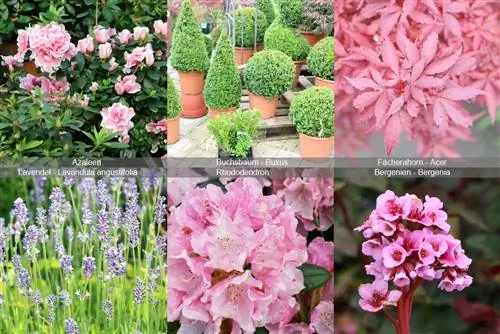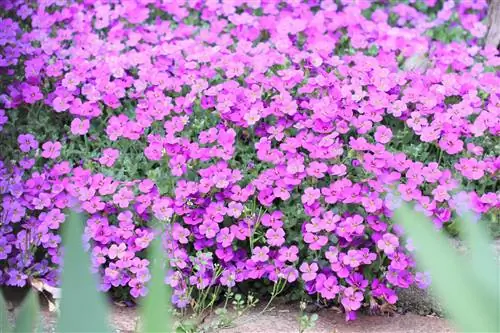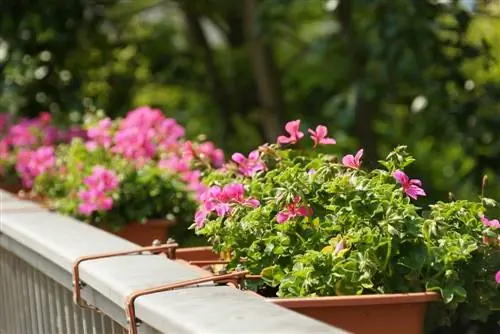- Author admin [email protected].
- Public 2023-12-17 03:39.
- Last modified 2025-06-01 06:48.
Cushion perennials can be found in many gardens. They are often used to green larger areas. The plants are ground-level plants that produce small flowers in large numbers and thus guarantee extensive planting.
Colorful perennial cushions for every occasion
In addition to being used in the garden, these plants are also often used for grave care as they are very undemanding and robust. Ideal for all those places that cannot be managed permanently. Whether gardening, grave care or planting dry stone walls - upholstery perennials have many areas of application. The great color options available here should appeal to every taste.
Cushion perennials - species
Upholstery plants are available in many designs and colors. Particularly popular are blue cushion, evergreen saxifrage, cushion phlox, hornwort or October gentian and Pentecost carnation. There are also carpet gypsophila and candytuft.
- Candytuft: The candytuft, for example, has a well-grown white flower pad that can reach a height of 30 cm. This makes the candytuft one of the tallest cushion perennials currently known. The special thing about this species is the fact that it is green even in winter and therefore brings a splash of color to every garden even in the cold season.
- Carpet Gypsophila: Carpet Gypsophila blooms in the colors pink and white, among other colors. It spreads out like a carpet and is therefore ideal for planting even larger areas. The small flowers can be admired from June until late autumn.
- Peony Carnation: The Peony Carnation is a cushion perennial that delights in the colors pink, white and light purple. The flowering time is in May and June. The foliage of the Peony carnation is particularly interesting. This shines in a steel blue, so that there is a great color even outside of the flowering period. In the wild, the Peony carnation is usually found in stony and rocky areas. If the popular plant is to grow in the garden, it would be nice if the appropriate conditions could be met.
- October Gentian: The October Gentian impresses with its beautiful blue colors. But the beautiful blue also has its price. This type of cushion perennial is very demanding. Therefore, only a few gardening enthusiasts manage to cultivate these plants in the garden. For this to be successful, the soil should be acidic and contain as many nutrients as possible.
- Hornwort: Hornwort is one of the best-known upholstery perennials. It not only has silver foliage, but also small white flowers. These can be seen in May and June. Hornwort grows particularly well on walls and in shady places. Hornwort is also very frugal when it comes to water absorption. A little water is enough for the herb to grow well.
- Cushion phlox: The two-colored flowers of the cushion phlox can be admired from April to May. To prevent the plant from overgrowing, the shoots can be cut off without damaging the plant. This plant grows particularly well in sandy soil or simple garden soil. Regular but not too intensive watering is recommended.
- Evergreen moss saxifrage: Evergreen moss saxifrage is available in a wide variety of colors. In May and June, this plant blooms in colors such as pink, white or a strong red. It feels particularly comfortable in rock gardens that are only sparingly watered. After flowering, the moss saxifrage continues to look beautiful thanks to its green color. However, the splashes of color are missing, so that this plant only shines in a rich green.
- Blue cushion: One of the most famous rock garden plants is the blue cushion. It blooms from April to May in a variety of colors. The colors carmine red, light purple and white are particularly popular. To create a beautiful carpet, several plants should be planted. These grow together and then form a nice, dense carpet.
Tip:
Cushion perennials can only be propagated to a limited extent. Therefore, you should buy the plants from a gardening store when new ones are needed. It is less complicated and not a big cost factor. The selection is also quite large, so that a beautiful, colorful carpet of plants can be created.
Care tips
Cushion perennials are best planted in the months March to May or September to October. But before this can happen, it must be clarified where the perennials should be planted. Since upholstered perennials require an uncomplicated environment, a rock garden, a wall or even a shady spot is the best solution. Some cushion perennials spread quite well, so the plants don't need to be planted too closely. All you need to do is have a little patience so that the plants form a beautiful carpet. After flowering, most cushion plants have strong foliage colors, so there is a splash of color here too.
The cushion perennials only need to be watered moderately. There should be no waterlogging. Care must also be taken to ensure that the soil does not dry out too much. Even if the plants grow quite well in a rock garden, this does not mean that they can survive completely without water. In spring it is important that the soil around the cushion perennials is loosened. Watering should be done in the early morning hours or later in the evening so that the water does not evaporate straight away and has enough time to seep into the ground. To ensure that the cushion perennials survive the winter well, they can be covered slightly during the winter months. Straw or leaves are particularly suitable for this. Tip: Upholstery perennials are only cut to a limited extent and when necessary. In the best case scenario, only the outdoor areas are straightened so that the plants don't spread too much.
Frequently asked questions
Where do cushion perennials grow best?
Cushion perennials do not require any special space. They grow in the front garden, rock garden and on the grave as well as on stone walls.
When do cushion perennials bloom?
Cushion perennials bloom in many different colors in spring. After flowering you can enjoy the foliage.
How should it be watered?
Cushion perennials do not require too much water. If watering is necessary, this should be done early in the morning or late in the evening. Care should be taken to ensure that no waterlogging occurs.
What you should know about upholstery perennials in brief
- Cushion perennials are particularly popular for rock gardens. But they also work well as underplanting, as a path and bed border, for dry stone walls and for grave planting.
- They grow together to form cushions or carpets, but can also ooze out of cracks and joints and overflow stones. They form beautiful flower cushions.
- They are mostly used as ground cover perennials. Cushion perennials compete with weeds because they cover a lot of area. They achieve the best effect in plant carpets.
- Most upholstery perennials love a sunny location. But many also grow in partial shade.
- Most upholstery perennials do well in poor soil. It just needs to be permeable so that the heat-loving roots can spread flat.
- The planting distance should be taken into account when planting. It should be 30 to 40 cm.
- Although the planting looks a bit sparse in the first two years, the perennials grow together quickly and the effect is then more impressive.
- The plants are often very frugal. They get along with little water and little fertilizer.
- If the cushions get too big, you can divide them. This is best done after flowering. This way you can easily propagate the perennials.
- Propagation can also be achieved through cuttings. After replanting, water must be sufficient.
- All upholstery perennials should be cut back after flowering to prevent baldness and excessive spreading. You cut away about 1/3 to 1/2 of the plant.
- Particularly beautiful upholstery perennials are blue cushions, alyssum, goose cress, candytufts, dwarf irises, upholstery phlox, hornwort, carnation, gentian, moss saxifrage and prickly nuts.

